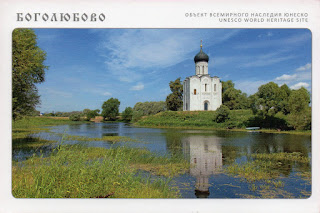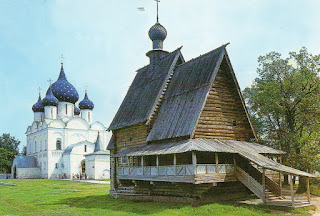This site includes eight medieval limestone monuments from the late 12th and early 13th centuries.
 |
| Assumption Cathedral |
This postcard was sent by Elena
Dormition Cathedral in Vladimir (sometimes translated Assumption Cathedral) used to be a mother church of medieval Russia in the 13th and 14th centuries.
The cathedral was commissioned by Andrew the Pious in his capital Vladimir and dedicated to the Dormition of the Theotokos (Virgin Mary), whom he promoted as the patron saint of his lands. Originally erected in 1158-1160, the 6-pillared 5-domed cathedral was expanded in 1185-1189 to reflect the augmented prestige of Vladimir. Embracing the area of 1178 sq. meters, it remained the largest of Russian churches for the following 300 or 400 years.
Andrew the Pious, Vsevolod the Big Nest, and other rulers of Vladimir-Suzdal were interred in the crypt of this church. Unlike many other churches, the cathedral survived the great devastation and fire of Vladimir in 1239, when the Mongol hordes of Batu Khan took hold of the capital.
The exterior walls of the church are covered with elaborate carvings. The interior was painted in the 12th century and then repainted by the great Andrei Rublev and Daniil Chernyi in 1408. The Dormition Cathedral served as a model for Aristotele Fioravanti when he designed thee ponymous cathedral in the Moscow Kremlin in 1475-1479. A lofty belltower, combining genuinely Russian, Gothic, and Neoclassical influences, was erected nearby in 1810. - in: wikipedia
 |
| Golden Gate |
This postcard was sent by Natasha
The Golden Gate of Vladimir, constructed between 1158 and 1164, is the only (albeit partially) preserved ancient Russian city gate. A museum inside focuses on the history of the Mongol invasion of Russia in the 13th century.
The Golden Gates existed in the holiest cities of Eastern Orthodoxy: Jerusalem, Constantinople, and Kiev. On making Vladimir his capital, Andrew the Pious aspired to emulate these structures, commissioning a lofty tower over the city's main gate to be erected in limestone and lined with golden plaques. According to ancient Russian chronicles, the masons were invited from Friedrich Barbarossa. The main arch used to stand 85 meters tall. The structure was topped with a barbican church dedicated to the Deposition of the Virgin's Robe and symbolizing theTheotokos's protection of Andrew's capital.
The gate survived the Mongol destruction of Vladimir in 1237. By the late 18th century, however, the structure had so deteriorated that Catherine the Great was afraid to pass through the arch for fear of its tumbling down. In 1779, she ordered detailed measurements and drawings of the monument to be executed. In 1795, after many discussions, the vaults and barbican church were demolished. Two flanking round towers were constructed in order to reinforce the structure, and artisans then reconstructed the barbican, following the drawings made in 1779. - in: wikipedia
 |
| Staircase Tower and Church of the Nativity of the Virgin |
This postcard was sent by Natasha
It was built in 1158-1164 on the bank of the Klyazma river ten kilometers from Vladimir. It looked as a town encircled by earth ramparts, white stone walls and moats. The white stone residence was remarkable for its beauty. The church of the Nativity of the Holy Virgin was connected to the living quarters and the fortress wall by the galleries and towers.
The cathedral was decorated with carved relief's, frescoes, copper and gilt details, ceramic floors and stained glass windows. Marble-like painting decorated round columns supporting the vault and the cupola. At the entrance to the cathedral stood a wonderful font under a canopy. The square was paved with white stone slabs.
Andrei Bogolyubsky spent here 17 years of his reign and was murdered here in the staircase tower in 1774. This very two-tiered tower and the gallery attached to it are the only fragments that have survived out of the numerous buildings of the royal residence.
After the prince's death a monastery has been established in Bogolyubovo. The ancient cathedral crumbled away with age and in the 18th century was replaced with a new one. A hipped roofed belfry was built over the staircase tower.
In the 19th century the high above - the-gate church of the Assumption with a bell-tower and the huge 5-domed cathedral were built. - in: http://www.cdo.vlsu.ru:8080/eng/geography_museum/bogolubovo/palace_of_prince_andrei_bogolyubsky/
 |
| Church of the Intercession on the Nerl |
This postcard was sent by Elena
The Church of the Intercession of the Holy Virgin on the Nerl River is an Orthodox church and a symbol of medieval Russia.
The church is situated at the confluence of Nerl and Klyazma Rivers in Bogolyubovo, Suzdalsky District, Vladimir Oblast, 13 km north-east of the ancient capital of Vladimir.
The church was commissioned by Andrei Bogolyubsky. According to some sources, it was built to commemorate Andrei's victory over the Bulgars and his son Izyaslav, who was slain in the battle. The exact construction date of the church is unknown.
The monument is built in white stone, and has one dome and four columns in the interior. Its proportions are elongated on purpose to make its outline seem more slender, although this architectural solution made its interior too dark for holding divine services. - in: wikipedia
This postcard was sent by Natalia
 |
| Cathedral of the Nativity of the Theotokos |
The Cathedral of the Nativity of the Theotokos in Suzdal Russia is a World Heritage Site. It is one of the eight White Monuments of Vladimir and Suzdal. One of the most complex monuments of Russian medieval architecture. It was originally constructed during the reign of Vladimir II Monomakh during the late 11th century.
The Cathedral of the Nativity is surrounded by a ring of earthen walls in an oxbow of Kamenka River. It is notable for being the first city cathedral not built for the exclusive use of the knyaz or his relatives. The cathedral contains the remains of a son of Yuri Dolgoruki, knyazes of the Shuisky family and others. - in: wikipedia |
| St Boris and St Gleb Church |
This postcard was sent by Natasha
The Church of Boris and Gleb is a church built in 1152, on the orders of Prince Yuri Dolgoruky, in Kideksha on the Nerl River, "where the encampment of Saint Boris had been". It was probably part of the princely (wooden) palace complex, but was only used by Dolgorukii for a few years before he left to become Grand Prince of Kiev in 1155.
This postcard was sent by Maria on behalf of Luzia
 |
| St Boris and St Gleb Church |
The church, built in limestone probably by architects from Galicia, is a four-piered, three-apse church. It is one of the oldest in the district and one of the few churches built by Dolgorukii that is still extant. It retains fragments of frescoes dating back to the twelfth century. In the medieval period it was the site of a monastery and was then a parish church. The building has been significantly altered over the centuries. It lost its original vaulting and dome (the current roof and small dome date to the seventeenth century) and the apses are thought to be half their original height (their tops too were lost with the roof); a porch was added in the nineteenth century. - in: wikipedia
These are the 8 monuments included in the World Heritage list: (in red what I already have)
- Cathedral of the Assumption in Vladimir
- Golden Gate in Vladimir
- Prince Castle in Bogolyubovo (Cathedral of the Nativity of the Virgin and Staircase Tower of the Palace of Andrei Bogolyubsky
- Church of the Intercession on the River Nerl
- Cathedral of Saint Demetrius in Vladimir
- Kremlin of Suzdal and Cathedral of Nativity
- Monastery of Our Savior and St Euthymius in Suzdal
- Church of Sts Boris and Gleb in Suzdal





























